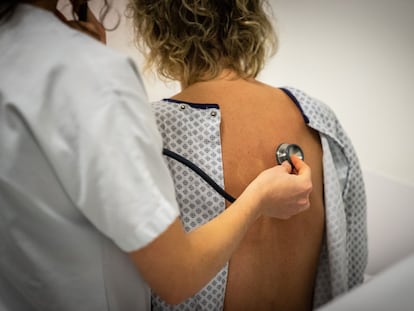A scientific ‘sisterhood’ explores the microbial mysteries of the vagina
A group of specialists emphasizes the urgent need for in-depth studies into vaginal microorganisms and their impact on health: ‘More research is needed’


Half the planet has a vagina, but scientific knowledge about this genital organ is still limited. So much so that we don’t even know precisely which microbes populate the vaginal ecosystem of a healthy woman, or how this microbiome influences health and disease. In an opinion article published on Thursday in the journal Trends in Microbiology (from the Cell Press group), a scientific sisterhood has spotlighted these gaps in knowledge, diving into the microbial mysteries that still surround the female reproductive system. The researchers, part of the Isala Sisterhood consortium, criticize the disparity in research in this area and warn of the urgent need to understand what constitutes a healthy microbiome in these organs.
“Women’s bodies, and knowledge concerning their health have been neglected, controlled, and persecuted for centuries, resulting in a health disparity that persists today,” the scientists caution in their article. They suggest that one way to address the gender health gap may lie “in women’s microorganisms.” “Conditions related to the female reproductive tract are among the most pressing health issues that women face and include noncommunicable gynecological and reproductive conditions and infections. Many of these conditions have been associated with the vaginal microbial community or microbiota inhabiting the reproductive tract, consisting of bacteria, archaea, fungi, and viruses,” explains the op-ed.
The hypothesis is not far-fetched, but the challenge lies in the fact that our knowledge of the vaginal microbiome is still limited. One reason for this, says Sarah Lebeer, author of the article, is that historically “microbiology has focused primarily on infections rather than on health-promoting microbes.” Later, with the rise in the use of antibiotics, she explains, “the focus shifted to eradicating pathogens rather than understanding beneficial bacteria.”
However, in recent years, the tide has begun to turn. A growing scientific movement is emerging to explore the vaginal microbiome beyond its role in disease. Lebeer, a researcher at the Applied Microbiology and Biotechnology Laboratory at the University of Antwerp in Belgium, is one of the minds driving this change. She is part of the Isala Sisterhood, a citizen science project launched in 2020 aimed at investigating the composition and function of the vaginal microbiome in healthy women, outside of clinical settings.
“The excitement and need for more research in this field inspired scientists around the world to initiate Isala Sisterhood projects,” Lebeer explains by email. “Recognizing the growing global interest and the importance of breaking the taboos surrounding this vital organ, we felt the time was right to consolidate current knowledge. With this article, we aimed to highlight the diversity of the vaginal microbiome while also emphasizing the need for nuance and careful consideration of bias in research on this important microbial organ.” The scientific network, which began in Belgium, has since expanded across borders, now spanning a dozen countries.
A key piece in health
If there’s one thing scientists agree on, it’s that the vaginal microbiome is a fundamental component of women’s health. “A balanced microbiome helps prevent infections and promotes a healthy pregnancy. Lactobacillus bacteria are important guardians that help maintain the balance of the vaginal microbiome in most of the cohorts studied worldwide to date,” says Lebeer.
Similarly, any imbalance in this natural coexistence of microbes increases the risk of bacterial vaginosis, vaginal infections caused by the Candida fungus, urinary tract infections, and sexually transmitted diseases, explains the Belgian researcher. “In addition, it increases the probability of cervical cancer mediated by the human papillomavirus, premature birth, and vaginal atrophy during menopause,” she concludes.
There’s no doubt about the benefits of a balanced microbiome, but one of the biggest gaps in our knowledge is what a healthy microbial ecosystem actually means. “We know that Lactobacillus species are particularly effective at keeping pathogens at bay, not only by producing lactic acid to maintain a low pH [low pH inhibits harmful viruses and bacteria], but also through other genes and molecules that support a symbiotic balance. However, future global research will be essential to identify other microbes with similar protective functions,” says Lebeer.
Another challenge in understanding the vaginal microbiome is the fact that not all women are the same. While some women have Lactobacillus-dominated microbial ecosystems, others may have a more diverse composition that could be equally or even more beneficial, says the Belgian researcher. “As an expert on Lactobacillus, I am firmly convinced of its crucial role in maintaining a healthy vaginal microbiome. However, I also believe that other bacterial species may offer similar protective benefits, and this is an area where more research is needed. When reviewing studies, I am always cautious about blanket claims suggesting that certain populations, such as Black women or those of non-Western European descent, have higher rates of dysbiosis [microbial imbalance]. It is important to approach these findings without a Western-centric perspective.”
The disparity in research in this field around the globe also hampers knowledge about the role of these microorganisms. In the article, in fact, the authors warn that low-income countries are underrepresented in studies on the microbiome: “It remains to be substantiated that women with different geographical backgrounds and ethnicity have indeed genuinely a different microbiota composition in the vagina in healthy conditions.”
In this regard, Lebeer adds: “Knowledge of the diversity of the vaginal microbiome cannot be a global project focused on the North and should not be aimed solely at developing knowledge, intellectual property and patents for Western organizations to profit from. This perpetuates the exploitative tradition of former colonial powers and the economic deprivation of low- and middle-income countries.”
Changes throughout life
On the other hand, the researcher points out that it is also important to take into account that the vaginal microbiome changes throughout life. It is dynamic and adapts to the physiological changes of women: it is influenced by hormones, menstruation, pregnancy, menopause, hygiene or the use of treatments, such as antibiotics or probiotics. And it is also shaped by genetics, diet, the environment, and cultural practices. “Understanding these changes can help guide strategies to maintain a balanced microbiome at different stages of life,” adds Lebeer.
During reproductive years, for example, Lactobacillus genera tend to dominate, whereas, during menopause, there is a reduction in this bacterial population, which leads to a less acidic vaginal environment (higher pH) and allows for an increase in other bacteria, some of which are associated with bacterial vaginosis and urinary tract infections, Lebeer explains. “Postmenopausal women with lower levels of Lactobacillus may experience increased vaginal dryness, irritation, and heightened susceptibility to infection. Hormone replacement therapy has been shown to partially restore a Lactobacillus-dominant microbiome, leading to improved vaginal health,” she says.
In any case, despite Isala’s advances in this field of study, many questions remain about the vaginal microbiome. And these unknowns are far from unimportant for women’s health, warns Lebeer: “Without a clear understanding of the composition and functions of the microbiome, our ability to diagnose, treat and prevent a variety of vaginal infections and diseases is limited. Conditions such as bacterial vaginosis, yeast infections and urinary tract infections often go undiagnosed or unmanaged appropriately because we do not fully understand the microbial factors at play.”
The scientist highlights that one of the most important knowledge gaps is precisely how little is known about this microbial variability among women around the world. Additionally, there is limited understanding within the scientific community regarding the functions of the vaginal flora and how this intricate network of microbes influences diseases. “This knowledge gap means that women may not receive the most effective and specific care. It is essential to carry out more research worldwide to improve diagnoses, develop better treatments and ensure that women’s health is prioritized in a comprehensive manner,” says Lebeer.
Gema Fernández Rivas, spokesperson for the Spanish Society of Infectious Diseases and Clinical Microbiology, supports the call for further study of the vaginal microbiome. “What this article says is interesting because it highlights the gap in research regarding women’s sexual and reproductive health,” says Fernández, a specialist in microbiology and parasitology at the Germans Trias i Pujol Hospital in Badalona.
The doctor suggests that while there is a growing understanding of the vaginal bacterial microbiome, “there may still be other domains of microorganisms yet to be explored.” She adds: “A deeper understanding of what happens and what is considered normal in such a varied world could help explain the pathophysiological mechanisms of disease. Understanding the interactions of cervical mucus and the communication between microorganisms could lead to significant improvements in women’s health.”
Sign up for our weekly newsletter to get more English-language news coverage from EL PAÍS USA Edition
Tu suscripción se está usando en otro dispositivo
¿Quieres añadir otro usuario a tu suscripción?
Si continúas leyendo en este dispositivo, no se podrá leer en el otro.
FlechaTu suscripción se está usando en otro dispositivo y solo puedes acceder a EL PAÍS desde un dispositivo a la vez.
Si quieres compartir tu cuenta, cambia tu suscripción a la modalidad Premium, así podrás añadir otro usuario. Cada uno accederá con su propia cuenta de email, lo que os permitirá personalizar vuestra experiencia en EL PAÍS.
¿Tienes una suscripción de empresa? Accede aquí para contratar más cuentas.
En el caso de no saber quién está usando tu cuenta, te recomendamos cambiar tu contraseña aquí.
Si decides continuar compartiendo tu cuenta, este mensaje se mostrará en tu dispositivo y en el de la otra persona que está usando tu cuenta de forma indefinida, afectando a tu experiencia de lectura. Puedes consultar aquí los términos y condiciones de la suscripción digital.

